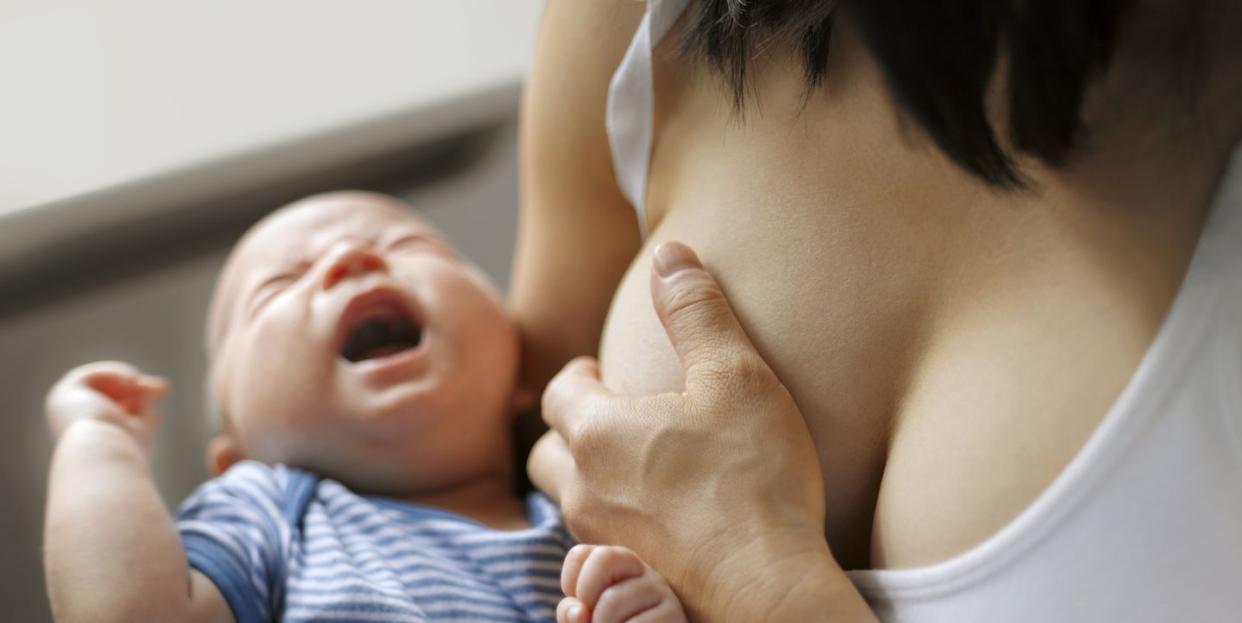Nipple thrush: symptoms, causes and treatment

Nipple thrush is common during breastfeeding. It is usually caused by a yeast infection that affects the nipples and surrounding skin (known as the areola). Although easily treated, nipple thrush can take time to settle.
If you’re wondering what nipple thrush looks like and the best ways to treat it, read on.
What is thrush?
Thrush is a common yeast infection that affects both sexes, typically in warm and moist environments such as the vagina, penis, armpits and groin, where an overgrowth of these organisms can occur. The usual fungal infection is a type of Candida albicans that lives naturally on our bodies and infection may occur for no clear reason, or it may be due to factors such as having a lowered immune system or taking a course of antibiotics. Thrush is not classified as a sexually transmitted infection (STI).
Nipple thrush causes
A baby’s mouth and a mother’s nipples can be an easy place for yeast to overgrow during breastfeeding because it thrives in warm and moist environments. If your baby develops thrush in its mouth, this can lead to the infection being passed back and forwards between mother and baby, and both may require treatment.
Nipple thrush symptoms
The most common symptom of nipple thrush is itchy and flaky skin on the nipples and areola area, sometimes with tenderness or discomfort to touch - this can be very significant, to the point where breastfeeding may be dreaded or stopped altogether. (A baby with oral thrush may have no obvious symptoms, or whitish patches on the tongue and irritation around the lips).
Nipple thrush is more likely to occur if the mother has thrush elsewhere, such as in the vagina, but is also more common in women with diabetes and anaemia.
Nipple thrush treatment
It is quite safe to continue breastfeeding if you are being treated for nipple thrush, and the usual treatment is typically a simple anti-fungal mouth rinse for baby, and a cream to put on and around the nipples. Examples of these antifungals include nystatin, clotrimazole and miconazole. This is only part of the treatment however, with hygiene and diet also playing an important part here.
Nipple thrush prevention
Always try to keep your breasts as dry a possible, since sweating and moisture on the breasts can increase the likelihood of thrush developing. Washing and toweling your breasts dry after breastfeeding can help, as can ‘air drying’ them using a hair dryer on a very low setting. If you use breast pads always make sure you use disposable ones that are changed after every feed, or if you use re-usable ones then wash these on a hot wash immediately. Wearing a clean cotton bra every day is important, and wash all your clothes in a 50 degree C wash whenever possible. (Thrush does not survive in acidic conditions so adding a small cup of white vinegar to baths and final washing machine rinses can help here).
Wash all of baby’s clothes separately, on a high heat setting and try to regularly clean items such as dummies, breast pumps and nipple shields with hot soapy water before thoroughly rinsing and drying them. Using a hot iron will also help to kill yeast.
Always wash your hands regularly after breastfeeding, and after putting anti-fungal ointment on your breasts.
Dietary options include cutting back on the amount of sugar you have in your diet (this is important since yeast feeds on sugar), adding a probiotic into your diet to help restore the natural balance of bacteria in your body, and making sure you eat a varied diet rich in fresh fruit and vegetables and avoiding highly processed and sweetened foods, including sweeteners.
If thrush persists for several weeks, or returns quickly once it has cleared, speak with your health professional about it.
Oral thrush in babies
It is thought that around two thirds of babies develop a degree of oral thrush at some time, and usually – but not always – occurs under the age of 3 months. The usual symptoms are of whitish spots in the mouth and on the tongue which may cause no symptoms or be sore, causing baby to refuse feeds, be unhappy, or drool saliva. Bottle-fed babies appear slightly more likely to develop it but it can occur for no obvious reason.
Many cases of oral thrush in babies are mild, settle by themselves in a few days and require no treatment. If it does, then gels or drops are used to clear it. The usual gel is called miconazole which is smeared onto the affected areas by a clean finger, and the drops are typically nystatin which is applied by a dropper onto the affected areas. The gel is usually used first with drops being used if these are ineffective for any reason. Continue any treatment for 48 hours after the thrush seems to have cleared away and then stop.
If you bottle-feed your baby, always sterilise all feeding equipment – including teats – regularly, as well as any other mouth toys or soothers your baby uses.
Last updated: 14.08.2020
You Might Also Like


